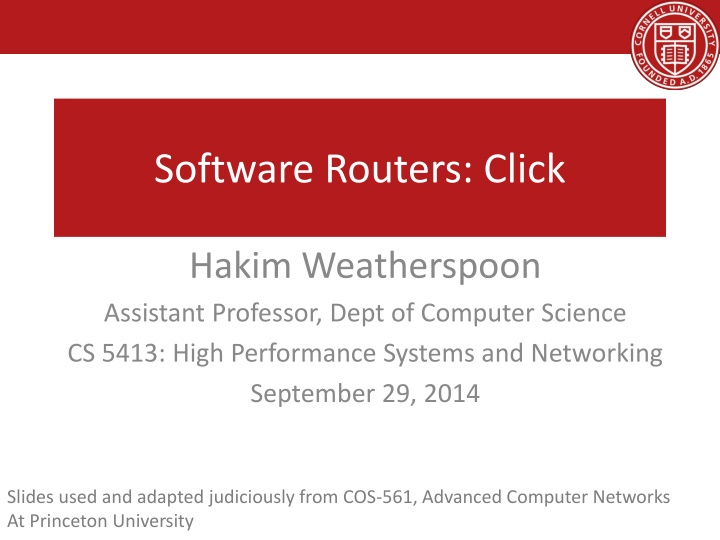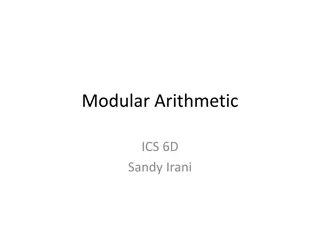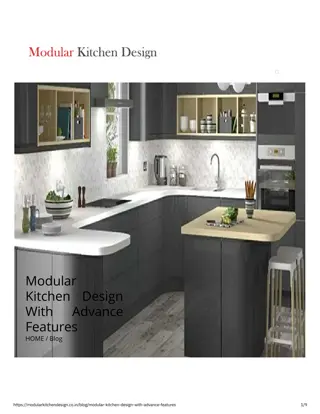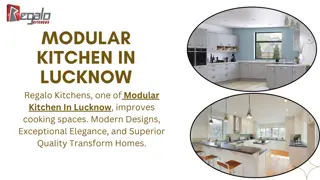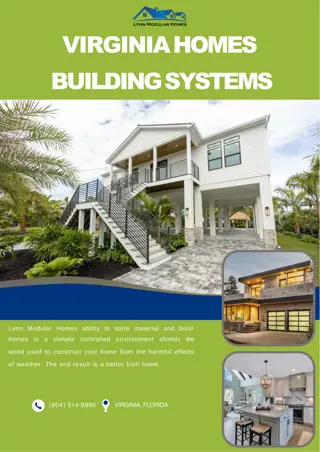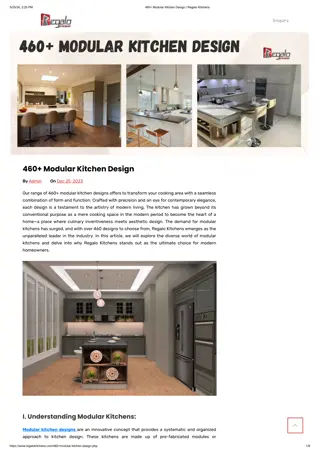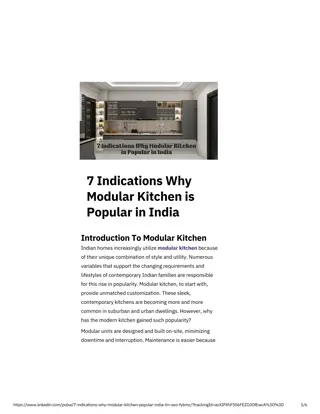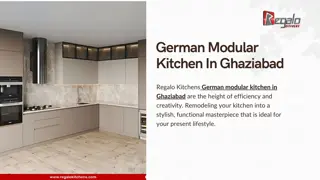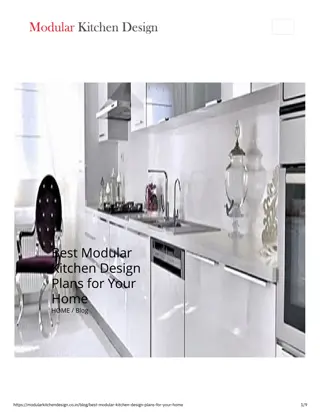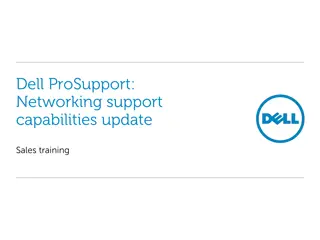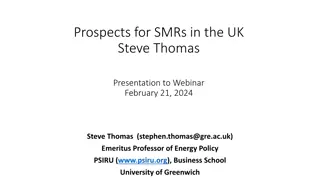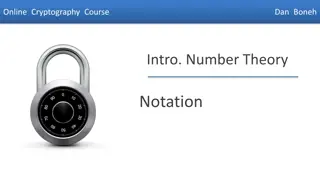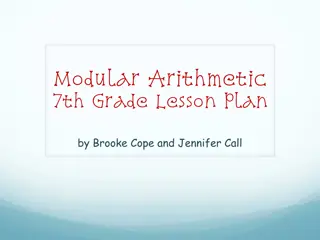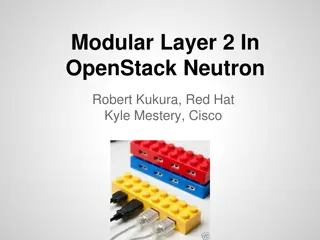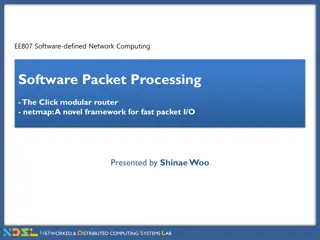Click Modular Router: Enhancing Networking Capabilities
The Click Modular Router, introduced by Hakim Weatherspoon, offers a flexible and open approach to networking by enabling easy addition of new features and experimentation. It simplifies feature composition, enhances speed and efficiency, and operates efficiently within the operating system. This system organizes routers as graphs of interconnected elements, allowing for simple packet functions like IP look-up and buffering. The Click language facilitates the declaration of elements, connections, and compound elements for network configuration. Embracing modularity, simplicity, and speed, Click empowers users and researchers to build and extend networking capabilities efficiently.
Download Presentation

Please find below an Image/Link to download the presentation.
The content on the website is provided AS IS for your information and personal use only. It may not be sold, licensed, or shared on other websites without obtaining consent from the author.If you encounter any issues during the download, it is possible that the publisher has removed the file from their server.
You are allowed to download the files provided on this website for personal or commercial use, subject to the condition that they are used lawfully. All files are the property of their respective owners.
The content on the website is provided AS IS for your information and personal use only. It may not be sold, licensed, or shared on other websites without obtaining consent from the author.
E N D
Presentation Transcript
Software Routers: Click Hakim Weatherspoon Assistant Professor, Dept of Computer Science CS 5413: High Performance Systems and Networking September 29, 2014 Slides used and adapted judiciously from COS-561, Advanced Computer Networks At Princeton University
Goals for Today The Click Modular Router E. Kohler, R. Morris, B. Chen, and M. F. Kaashoek. ACM Symposium on Operating Systems Principles (SOSP), December 1999, pages 217-23.
Click Motivation Flexibility Add new features Enable experimentation Openness Allow users/researchers to build and extend (In contrast to most commercial routers) Modularity Simplify the composition of existing features Simplify the addition of new features Speed/efficiency Operation (optionally) in the operating system Without the user needing to grapple with OS internals
Router as a Graph of Elements Large number of small elements Each performing a simple packet function E.g., IP look-up, TTL decrement, buffering Connected together in a graph Elements inputs/outputs snapped together Beyond elements in series to a graph E.g., packet duplication or classification Packet flow as main organizational primitive Consistent with data-plane operations on a router (Larger elements needed for, say, control planes)
Click Elements: Push vs. Pull Packet hand-off between elements Directly inspired by properties of routers Annotations on packets to carry temporary state Push processing Initiated by the source end E.g., when an unsolicited packet arrives (e.g., from a device) Pull processing Initiated by the destination end E.g., to control timing of packet processing (e.g., based on a timer or packet scheduler)
Click Language Declarations Create elements Connections Connect elements src :: FromDevice(eth0); ctr :: Counter; sink :: Discard; src -> ctr; ctr -> sink; Compound elements Combine multiple smaller elements, and treat as single, new element to use as a primitive class Language extensions through element classes Configuration strings for individual elements Rather than syntactic extensions to the language
Modular software forwarding plane: Click modular router Control plane Elements Small building blocks, performing simple operations Instances of C++ classes Packets traverse a directed graph of elements FromDevice(eth0)->CheckIPHeader(14) ->IPPrint->Discard; User-level routing daemons Linux kernel Click Forwarding plane Kohler, E., Morris, R., Chen, B., Jannotti, J., Kaashoek, M. F., The click modular router, ACM Trans. Comput. Syst. 18, 3 (Aug. 2000) Andrea Bianco, Robert Birke, Davide Bolognesi, Jorge M. Finochietto, Giulio Galante, Marco Mellia, Click vs. Linux: Two Efficient Open-Source IP Network Stacks for Software Routers, HPSR 2005
Elements PATS Research Group 16-3-2025 9
Push and Pull Pull connection Destination pulls packets from upstream Packet transmission or scheduling Denoted by empty square or triangle Push connection Source pushes packets downstream Triggered by event, such as packet arrival Denoted by filled square or triangle Agnostic connection Becomes push or pull depending on peer Denoted by double outline PATS Research Group 16-3-2025 10
Push and pull violations PATS Research Group 16-3-2025 11
Handlers and Control Socket Access points for user interaction Appear like files in a file system Can have both read and write handlers Examples Installing/removing forwarding-table entries Reporting measurement statistics Changing a maximum queue length Control socket Allows other programs to call read/write handlers Command sent as single line of text to the server http://read.cs.ucla.edu/click/elements/controlsocket?s=llrpc
Example: EtherSwitch Element Ethernet switch Expects and produces Ethernet frames Each input/output pair of ports is a LAN Learning and forwarding switch among these LANs Element properties Ports: any # of inputs, and same # of outputs Processing: push Element handlers Table (read-only): returns port association table Timeout (read/write): returns/sets TIMEOUT http://read.cs.ucla.edu/click/elements/etherswitch
Implicit vs explicit queues Implicit queue Used by STREAM, Scout, etc. Hard to control Explicit queue Led to push and pull, Click s main idea Contributes to high performance
An Observation Click is widely used And the paper on Click is widely cited Click elements are created by others Enabling an ecosystem of innovation Take-away lesson Creating useful systems that others can use and extend has big impact in the research community And brings tremendous professional value Compensating amply for the time and energy
Improving software router performance: exploiting parallelism Can you build a Tbps router out of PCs running Click? Not quite, but you can get close RouteBricks: high-end software router Parallelism across servers and cores High-end servers: NUMA, multi-queue NICs RB4 prototype 4 servers in full mesh acting as 4-port (10Gbps/port) router 4 8.75 = 35Gbps Linearly scalable by adding servers (in theory) Dobrescu, M., Egi, N., Argyraki, K., Chun, B., Fall, K., Iannaccone, G., Knies, A., Manesh, M., and Ratnasamy, S. RouteBricks: exploiting parallelism to scale software routers, SOSP 2009 Bolla, R. and Bruschi, R., PC-based software routers: high performance and application service support, PRESTO 2008
Improving software router performance: specialized hardware NetFPGA Network processor QuickTime and a decompressor are needed to see this picture. QuickTime and a decompressor are needed to see this picture. Jad Naous, Glen Gibb, Sara Bolouki, Nick McKeown, NetFPGA: Reusable Router Architecture for Experimental Research, PRESTO 2008 Spalink, T., Karlin, S., Peterson, L., and Gottlieb, Y., Building a robust software-based router using network processors, SOSP 2001 J. Turner, P. Crowley, J. Dehart, A. Freestone, B. Heller, F. Kuhms, S. Kumar, J. Lockwood, J. Lu, M.Wilson, C. Wiseman, D. Zar, Supercharging PlanetLab A High Performance, Multi-Application, Overlay Network Platform, SIGCOMM 2007 Tilman Wolf, Challenges and applications for network-processor-based programmable routers, IEEE Sarnoff Symposium, Princeton, NJ, Mar. 2006
Before Next time Project Progress Need to setup environment as soon as possible And meet with groups, TA, and professor Lab0b Getting Started with Fractus Use Fractus instead of Red Cloud Red Cloud instances will be terminated and state lost Due Monday, Sept 29 Required review and reading for Friday, October 3 RouteBrics Check piazza: http://piazza.com/cornell/fall2014/cs5413 Check website for updated schedule
